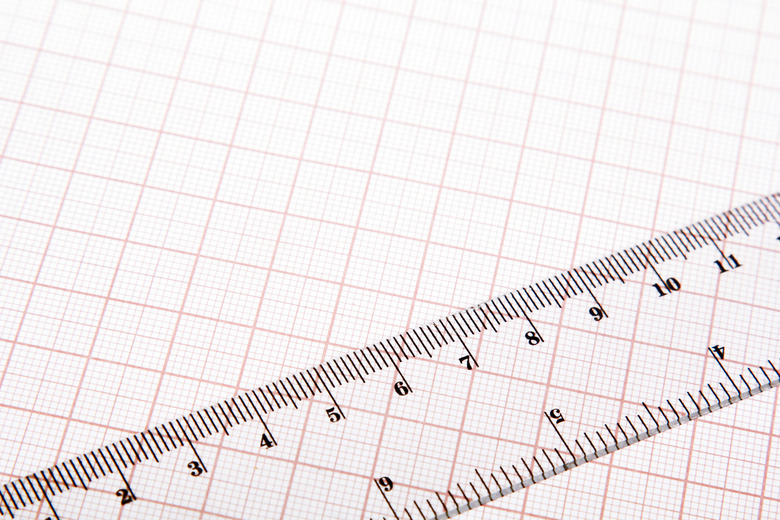How To Understand The Metric System For Kids
Learning about the metric system of measurement does not have to be a difficult or unnerving task. In many ways, metric measurement is much easier to master than the English system. All that is really required is memorization of the size prefixes in order and the ability to follow rules by rote. Older students will benefit from the application of knowledge about decimal fractions.
Teach the Vocabulary
Step 1
Introduce the metric base measures: meter for length and distance, gram for mass or weight, and liter for volume. Practice classifying measuring tasks according to the most appropriate unit. This can be done orally or in written form. Students may enjoy a scavenger hunt where players locate items to measure with each type of unit.
Step 2
Introduce the common metric prefixes: kilo-, hecto-, deka-, deci-, centi- and milli-. Use a chart to show relative sizes by placing the prefixes in order from largest to smallest.
Step 3
Help students memorize the relative sizes of metric prefixes using a mnemonic such as "Kitchens have delightful brown dragons carrying mushrooms."
Teach the Conversion Process
Step 1
Create a metric prefix chart with boxes beneath each prefix. Duplicate or display this aid for students to use in the learning process.
Step 2
Teach students to write the metric measure to be converted into the boxes below the prefix titles, one digit in each box. Put the ones place digit into the box below the unit name. For example, 23.6 centimeters would have the 3 in the box below centimeters.
Step 3
Teach students to put the decimal point on the grid line after the box containing the ones place digit. For 23.6 centimeters, the three is written in the box below centimeters, and the decimal point should be placed on the line between the three and the six.
Step 4
To convert to a different size of metric measure, simply move the decimal point to the line that is to the right of the corresponding prefix name. If converting 23.6 centimeters to millimeters, place the new decimal point on the line to the right of the millimeters column. Fill in zeros as needed in any empty boxes between the old number and the new decimal point.
Step 5
Decrease use of the chart as students become proficient moving the decimal point the correct number of places to right or left and placing zeros into the new number correctly.
Teach Decimal Manipulation Using Multiplication and Division
Step 1
Review place value concepts using base-ten blocks or similar manipulatives. Students should understand that ten unit blocks combine to form a tens block, 10 ten-blocks combine to form a hundred block, and so forth.
Step 2
Rename the base-ten blocks to demonstrate concepts related to decimal fractions. For example, the unit blocks might be renamed tenths blocks. Ten must now be joined to form a new unit block.
Step 3
Make number models to match manipulations of the base-ten blocks. Joining ten blocks to form the next type of block can be written as multiplying by ten. Separating blocks into their component pieces can be written as dividing by ten.
Step 4
Demonstrate how multiplication and division by multiples of ten causes the decimal point to move when number models are used. Have students practice until proficient.
Step 5
Demonstrate how to use this concept of multiplication and division by multiples of ten to solve metric conversion problems. Have students practice these conversions until proficient.
Things Needed
- Metric measuring tools
- Paper and pencil
- Metric prefix chart
- Base-ten blocks or similar manipulatives (optional)
TL;DR (Too Long; Didn't Read)
Play matching games that require students to recognize equivalent amounts such as 3 meters and 300 centimeters.
Warning
Younger students will need many concrete experiences with these ideas and they may not be prepared to understand the symbolic notation of multiplying or dividing to convert between metric units.
References
- "Teaching Learners Who Struggle With Mathematics: Systematic Intervention and Remediation"; Helene Sherman, Lloyd Richardson and George Yard; 2009
- "Math Matters: Understanding the Math You Teach"; Suzanne Chapin and Art Johnson; 2006
- Teaching the Metric System for America's Future
Cite This Article
MLA
Fleming, Sandy. "How To Understand The Metric System For Kids" sciencing.com, https://www.sciencing.com/how-to-understand-the-metric-system-for-kids-5658311/. 31 October 2018.
APA
Fleming, Sandy. (2018, October 31). How To Understand The Metric System For Kids. sciencing.com. Retrieved from https://www.sciencing.com/how-to-understand-the-metric-system-for-kids-5658311/
Chicago
Fleming, Sandy. How To Understand The Metric System For Kids last modified March 24, 2022. https://www.sciencing.com/how-to-understand-the-metric-system-for-kids-5658311/
